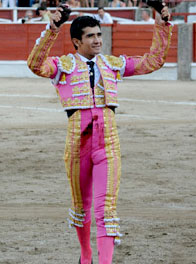Too Much of a Bad Thing: 4th Tijuana Corrida Leaves Aficionados Longing for Less…

Tijuana, B.C. Mexico– 4th Corrida of the 2014 Temporada
Two novillos (for rejones) and 5 toros (one gift bull) of Santa Fe del Campo, basically well presented, generally noble, somewhat weak, and one gift bull of Boquilla del Carmen, very poor.
Rejoneadora Monica Serrano (Mexican charro dress), Joselito Adame (Mexican pink and gold), and Octavio Garcia, “El Payo” (lilac and black embroidery).
There are those corridas, which “create aficion” or passion for the Fiesta Brava; those rare events when the bulls charge bravely, the toreros are creative and inspired, the mules don’t trip over their halters or leads, the crowd is only pleasantly buzzed and the judge generous. The kind of corrida that makes you want to return to experience the unique emotion and beauty that only the Fiesta can give.
This corrida was not one of them.
If our premonitory powers had been better synchronized, everyone would have packed up and left after international star Joselito Adame—returning to Mexico for a lightning round of five corridas before finishing a very successful (albeit, somewhat modest) Spanish campaign—cut two well deserved ears from “Merlot” (wine being the “mote” motif of the day), a beautiful gray and white collaborator from the Zacatecas ranch of Santa Fe del Campo. While lacking just a pinch more “empuje” (push or Uuummph!) was an animal fine enough for Adame to continue his improbable string of legitimate triumphs with a display of unusually elegant cape work, and an excellent faena that molded not only “Merlot’s” frank charges, but the bothersome Pacific gusts that constantly threatened to trash the whole thing. Slowness, control, and natural elegance were abounded in Adame’s latest triumph, and a devastatingly effective sword thrust had everyone believing that great things were in the offing.
Poof.
Just when it seemed that Adame’s second bull might be generous enough to round out a four-ear afternoon (Adame was holding nothing back), an ill-advised cape drew the animal into the protective burladero shield, cracking it’s horn—and the faena—at its base.
Adame tried to find the bull’s rhythm and compensate by working only on the left side of the undamaged horn, but the crowd was having none of it. The reglamento—or governing practices—of the corrida are slightly different at different rings (topic for another discussion) but in most, once the bull has been pic’d, it can’t be replaced, regardless of the cause. Adame later avowed that he had hoped for just such an action by ring president Fernando Galvan, who continues to incense dizzying passions with his unseemly attachment to the rules of the spectacle…
The gift bull—some poor relic from the Boquilla del Carmen ranch left over from the 2013 season—was simply a further argument for a long and loud campaign against the awarding of gift bulls AT ALL for ANY REASON.
Adame did everything but climb on the animal, to no avail. Protracted enclosure in reduced areas—as any old-school zoo will testify—results in functional paralysis. The faena was an exercise in Adame’s amazing ring craft—the animal did charge, because Adame simply wouldn’t take no for an answer. That, however, doesn’t mean it was worthwhile. Something similar to having an impacted molar extracted.
Octavio Garcia, “El Payo”, Adame’s compatriot in the Casa Toreros management group, once again found himself facing the agonizing deliberations of two pleasantly made bulls, neither of which transmitted anything at all to the fans or their matador.
As usual—and this is all to “Payo’s” credit as a legitimate and resurgent star on the Mexican scene—it was through no fault of his own that the surprisingly large crowd stifled polite yawns throughout both faenas. Poor sword work —again—may have cost him an ear, but that atypical silence that accompanied his work was significant. The corrida can be many things, but boring should never be one of them. Isolated moments and his resolute disposition were the best parts of his day.
Monica Serrano.
It’s probably best to be political in this regard, by that, I mean to euphemize my way around a terribly embarrassing performance.
Serrano was unseated, twice, in both instances due to her lack of judgement of the space necessary to avoid her opponent’s charges. That she was not seriously injured can only be attributed to divine mercy and the maddening lack of codicia—desire to charge—of the animals she faced.
Her placements of the rejones de castigo, banderillas and the rejon de muerte, were an attack on the Fiesta that even the most feverish anti-taurino couldn’t have hoped for; the bulls ended up as sickening pin-cushions in one of the most unprofessional performances this reporter has witnessed.
If—as taurinos—we want our heartfelt professions of respect and admiration for toro bravo to mean anything, then this type of performance, charging real money to humiliate and torture an animal simply because a spot on a cartel can be bought or bullied, cannot be tolerated.





